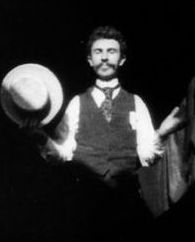
William Kennedy Laurie Dickson was a British inventor who devised an early motion picture camera under the employment of Thomas Edison.
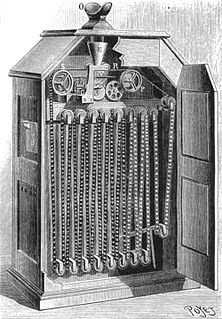
The Kinetoscope is an early motion picture exhibition device, designed for films to be viewed by one person at a time through a peephole viewer window. The Kinetoscope was not a movie projector, but it introduced the basic approach that would become the standard for all cinematic projection before the advent of video: it created the illusion of movement by conveying a strip of perforated film bearing sequential images over a light source with a high-speed shutter. First described in conceptual terms by U.S. inventor Thomas Edison in 1888, it was largely developed by his employee William Kennedy Laurie Dickson between 1889 and 1892. Dickson and his team at the Edison lab in New Jersey also devised the Kinetograph, an innovative motion picture camera with rapid intermittent, or stop-and-go, film movement, to photograph movies for in-house experiments and, eventually, commercial Kinetoscope presentations.
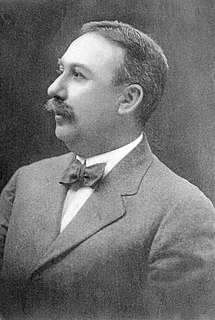
Edwin Stanton Porter was an American film pioneer, most famous as a producer, director, studio manager and cinematographer with the Edison Manufacturing Company and the Famous Players Film Company. Of over 250 films created by Porter, his most important include: What Happened on Twenty-third Street, New York City, (1901), ; Jack and the Beanstalk (1902); Life of an American Fireman (1903); The Great Train Robbery (1903); The European Rest Cure (1904); The Kleptomaniac (1905); Life of a Cowboy (1906); Rescued from an Eagle's Nest (1908); and The Prisoner of Zenda (1913).

Vitascope was an early film projector first demonstrated in 1895 by Charles Francis Jenkins and Thomas Armat. They had made modifications to Jenkins' patented Phantoscope, which cast images via film and electric light onto a wall or screen. The Vitascope is a large electrically-powered projector that uses light to cast images. The images being cast are originally taken by a kinetoscope mechanism onto gelatin film. Using an intermittent mechanism, the film negatives produced up to fifty frames per second. The shutter opens and closes to reveal new images. This device can produce up to 3,000 negatives per minute. With the original Phantoscope and before he partnered with Armat, Jenkins displayed the earliest documented projection of a filmed motion picture in June 1894 in Richmond, Indiana.

Edison Studios was an American film production organization, owned by companies controlled by inventor and entrepreneur, Thomas Edison. The studio made close to 1,200 films, as part of the Edison Manufacturing Company (1894–1911) and then Thomas A. Edison, Inc. (1911–1918), until the studio's closing in 1918. Of that number, 54 were feature length, and the remainder were shorts. All of the company's films have fallen into the public domain because they were released before 1925.
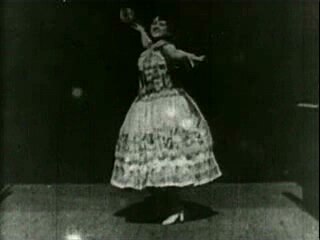
Carmencita is an 1894 American short black-and-white silent documentary film directed and produced by William K.L. Dickson, the Scottish inventor credited with the invention of the motion picture camera under the employ of Thomas Edison. The film is titled after the dancer who features in it.
The decade of the 1890s in film involved some significant events.

Another Job for the Undertaker is a 1901 silent comic trick film made at Edison's recently opened studio at 41 East 21st Street in Manhattan. It was photographed by Edwin S. Porter and co-directed by Porter and George S. Fleming. The two-shot film was copyrighted on May 15, 1901 and is approximately two minutes in length. It lacks a head title, which would have been supplied by projecting a separate lantern slide before screening the film.
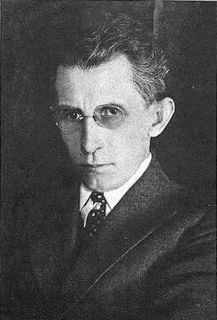
James Searle Dawley was an American film director, producer, screenwriter, stage actor, and playwright. Between 1907 and the mid-1920s, while working for Edison, Rex Motion Picture Company, Famous Players, Fox, and other studios, he directed more than 300 short films and 56 features, which include many of the early releases of stars such as Douglas Fairbanks, Mary Pickford, Pearl White, Marguerite Clark, Harold Lloyd, and John Barrymore. He also wrote scenarios for many of his productions, including one for his 1910 horror film Frankenstein, the earliest known screen adaptation of Mary Shelley's 1818 novel. While film direction and screenwriting comprised the bulk of Dawley's career, he also had earlier working experience in theater, performing on stage for more than a decade and managing every aspect of stagecraft. Dawley wrote at least 18 plays as well for repertory companies and for several Broadway productions.

The Charge of the Light Brigade is a 1912 American silent historical drama film directed by J. Searle Dawley. Produced by Edison Studios, the film portrays the disastrous yet inspiring military attack in October 1854 by British light cavalry against Russian artillery positions in the Battle of Balaclava during the Crimean War. Director Dawley also wrote the scenario for this production, adapting it in part from the famous 1854 narrative poem about the charge by British poet laureate Alfred, Lord Tennyson, who completed his poem just six weeks after the actual event. The film's action scenes and landscape footage were shot between late August and early September 1912, while Dawley and his company of players and crew were on location in Cheyenne, Wyoming. In order to produce a sizable and believable recreation of the charge, the director needed a very large number of horsemen. Fortunately for Dawley, the commander of United States Army cavalry at Fort D. A. Russell at Cheyenne agreed to provide "about 800" troopers and "their trained mounts" to the Edison project.
Charles John Musser is a film historian and documentary film maker. Since 1992 he has taught at Yale University, where he is currently a professor of Film and Media Studies as well as American Studies and Theater Studies. His research has focused on such topics as Edwin S. Porter and early cinema, Oscar Micheaux and race cinema of the silent era, Paul Robeson and film performance as well as a variety of issues and individuals in documentary. His films include An American Potter (1976), Before the Nickelodeon: The Early Cinema of Edwin S. Porter (1982) and Errol Morris: A Lightning Sketch (2014).

The Bermuda Garrison was the military establishment maintained on the British Overseas Territory and Imperial fortress of Bermuda by the regular British Army and its local militia and voluntary reserves from 1701 to 1957. The garrison evolved from an independent company, to a company of Royal Garrison Battalion during the American War of Independence, and a steadily growing and diversifying force of artillery and infantry with various supporting corps from the French Revolution onwards. During the American War of Independence, the garrison in Bermuda fell under the military Commander-in-Chief of America. Subsequently, it was part of the Nova Scotia Command until 1868, and was an independent Bermuda Command from then 'til its closure in 1957.

Kansas Saloon Smashers is a 1901 comedy short film produced and distributed by Edison Studios. Directed by Edwin S. Porter, it is a satire of American activist Carrie Nation. The film portrays Nation and her followers entering and destroying a saloon. After the bartender retaliates by spraying Nation with water, policemen order them out; the identities of the actors are not known. Inspiration for the film was provided by an editorial cartoon which appeared in the New York Evening Journal.
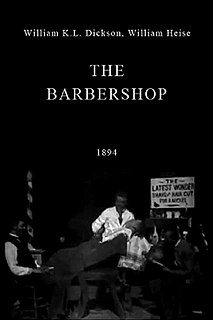
The Barbershop is an 1894 American short narrative film directed by William K.L. Dickson and William Heise. It was produced by the Edison Manufacturing Company at the Black Maria Studio, in West Orange, New Jersey. The Kinetoscope film has been described as Heise's most ambitious film production.
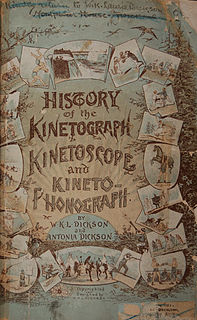
History of the Kinetograph, Kinetoscope, and Kinetophonograph is a book written by siblings William Kennedy Dickson and Antonia Dickson about the history of film. The brother Dickson wrote from his experiences working for Thomas Edison at his "Black Maria" studio in West Orange, New Jersey; Edison himself prefaced the book. Emphasis is placed on the eponymous devices: the kinetograph, the kinetoscope, and the kinetophonograph. Dickson helped to develop these devices, which facilitate the capturing and exhibition of motion pictures.
The Boston Tea Party is a 1908 silent film directed by Edwin S. Porter, and produced and distributed by Edison Studios. The film is a fictionalized depiction of the events of the December 16, 1773, Boston Tea Party. It was the film debut of actor Charles Stanton Ogle.

Norman C. Raff and Frank R. Gammon were two American businessmen who were known for distributing and promoting some of the Edison Studio films, and founding their own business, which was called The Kinetoscope Company.
The Relief of Lucknow is a 1912 American silent film about the Relief of Lucknow during the Indian Rebellion of 1857. Filmed in 1911 by the Edison Company at locations in the Imperial fortress colony of Bermuda, including the Prospect Camp Garrison Golf Links clubhouse, "Walsingham House", and the walled streets of St. George's town.
For Valour is a 1912 silent American short film made by the Edison Manufacturing Company. It stars Laura Sawyer, Richard R. Neill, Ben Wilson, and James Gordon. It is based on the short story of the same name by Talbot Mundy. It was directed by J. Searle Dawley.














